Karren Yang
Hypernetworks for Personalizing ASR to Atypical Speech
Jun 07, 2024Abstract:Parameter-efficient fine-tuning (PEFT) for personalizing automatic speech recognition (ASR) has recently shown promise for adapting general population models to atypical speech. However, these approaches assume a priori knowledge of the atypical speech disorder being adapted for -- the diagnosis of which requires expert knowledge that is not always available. Even given this knowledge, data scarcity and high inter/intra-speaker variability further limit the effectiveness of traditional fine-tuning. To circumvent these challenges, we first identify the minimal set of model parameters required for ASR adaptation. Our analysis of each individual parameter's effect on adaptation performance allows us to reduce Word Error Rate (WER) by half while adapting 0.03% of all weights. Alleviating the need for cohort-specific models, we next propose the novel use of a meta-learned hypernetwork to generate highly individualized, utterance-level adaptations on-the-fly for a diverse set of atypical speech characteristics. Evaluating adaptation at the global, cohort and individual-level, we show that hypernetworks generalize better to out-of-distribution speakers, while maintaining an overall relative WER reduction of 75.2% using 0.1% of the full parameter budget.
FastSR-NeRF: Improving NeRF Efficiency on Consumer Devices with A Simple Super-Resolution Pipeline
Dec 20, 2023



Abstract:Super-resolution (SR) techniques have recently been proposed to upscale the outputs of neural radiance fields (NeRF) and generate high-quality images with enhanced inference speeds. However, existing NeRF+SR methods increase training overhead by using extra input features, loss functions, and/or expensive training procedures such as knowledge distillation. In this paper, we aim to leverage SR for efficiency gains without costly training or architectural changes. Specifically, we build a simple NeRF+SR pipeline that directly combines existing modules, and we propose a lightweight augmentation technique, random patch sampling, for training. Compared to existing NeRF+SR methods, our pipeline mitigates the SR computing overhead and can be trained up to 23x faster, making it feasible to run on consumer devices such as the Apple MacBook. Experiments show our pipeline can upscale NeRF outputs by 2-4x while maintaining high quality, increasing inference speeds by up to 18x on an NVIDIA V100 GPU and 12.8x on an M1 Pro chip. We conclude that SR can be a simple but effective technique for improving the efficiency of NeRF models for consumer devices.
Novel-View Acoustic Synthesis from 3D Reconstructed Rooms
Oct 23, 2023
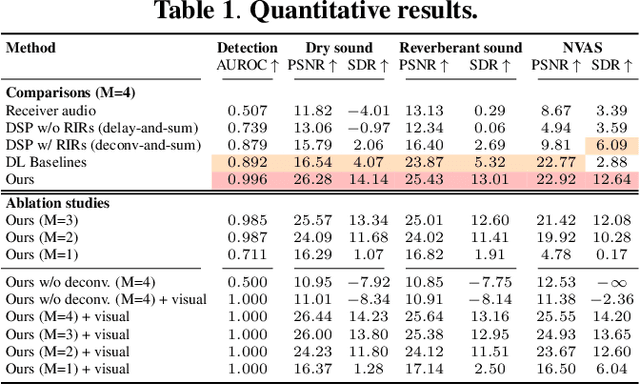
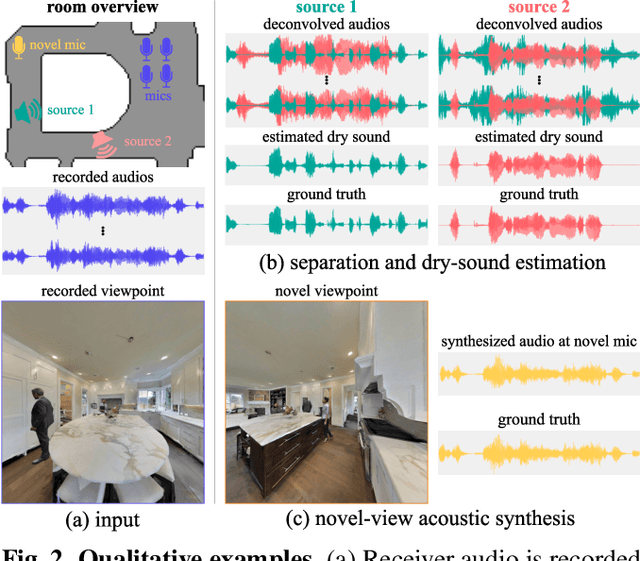
Abstract:We investigate the benefit of combining blind audio recordings with 3D scene information for novel-view acoustic synthesis. Given audio recordings from 2-4 microphones and the 3D geometry and material of a scene containing multiple unknown sound sources, we estimate the sound anywhere in the scene. We identify the main challenges of novel-view acoustic synthesis as sound source localization, separation, and dereverberation. While naively training an end-to-end network fails to produce high-quality results, we show that incorporating room impulse responses (RIRs) derived from 3D reconstructed rooms enables the same network to jointly tackle these tasks. Our method outperforms existing methods designed for the individual tasks, demonstrating its effectiveness at utilizing 3D visual information. In a simulated study on the Matterport3D-NVAS dataset, our model achieves near-perfect accuracy on source localization, a PSNR of 26.44 dB and a SDR of 14.23 dB for source separation and dereverberation, resulting in a PSNR of 25.55 dB and a SDR of 14.20 dB on novel-view acoustic synthesis. Code, pretrained model, and video results are available on the project webpage (https://github.com/apple/ml-nvas3d).
Corpus Synthesis for Zero-shot ASR domain Adaptation using Large Language Models
Sep 18, 2023Abstract:While Automatic Speech Recognition (ASR) systems are widely used in many real-world applications, they often do not generalize well to new domains and need to be finetuned on data from these domains. However, target-domain data usually are not readily available in many scenarios. In this paper, we propose a new strategy for adapting ASR models to new target domains without any text or speech from those domains. To accomplish this, we propose a novel data synthesis pipeline that uses a Large Language Model (LLM) to generate a target domain text corpus, and a state-of-the-art controllable speech synthesis model to generate the corresponding speech. We propose a simple yet effective in-context instruction finetuning strategy to increase the effectiveness of LLM in generating text corpora for new domains. Experiments on the SLURP dataset show that the proposed method achieves an average relative word error rate improvement of $28\%$ on unseen target domains without any performance drop in source domains.
Text is All You Need: Personalizing ASR Models using Controllable Speech Synthesis
Mar 27, 2023



Abstract:Adapting generic speech recognition models to specific individuals is a challenging problem due to the scarcity of personalized data. Recent works have proposed boosting the amount of training data using personalized text-to-speech synthesis. Here, we ask two fundamental questions about this strategy: when is synthetic data effective for personalization, and why is it effective in those cases? To address the first question, we adapt a state-of-the-art automatic speech recognition (ASR) model to target speakers from four benchmark datasets representative of different speaker types. We show that ASR personalization with synthetic data is effective in all cases, but particularly when (i) the target speaker is underrepresented in the global data, and (ii) the capacity of the global model is limited. To address the second question of why personalized synthetic data is effective, we use controllable speech synthesis to generate speech with varied styles and content. Surprisingly, we find that the text content of the synthetic data, rather than style, is important for speaker adaptation. These results lead us to propose a data selection strategy for ASR personalization based on speech content.
Defending Multimodal Fusion Models against Single-Source Adversaries
Jun 25, 2022



Abstract:Beyond achieving high performance across many vision tasks, multimodal models are expected to be robust to single-source faults due to the availability of redundant information between modalities. In this paper, we investigate the robustness of multimodal neural networks against worst-case (i.e., adversarial) perturbations on a single modality. We first show that standard multimodal fusion models are vulnerable to single-source adversaries: an attack on any single modality can overcome the correct information from multiple unperturbed modalities and cause the model to fail. This surprising vulnerability holds across diverse multimodal tasks and necessitates a solution. Motivated by this finding, we propose an adversarially robust fusion strategy that trains the model to compare information coming from all the input sources, detect inconsistencies in the perturbed modality compared to the other modalities, and only allow information from the unperturbed modalities to pass through. Our approach significantly improves on state-of-the-art methods in single-source robustness, achieving gains of 7.8-25.2% on action recognition, 19.7-48.2% on object detection, and 1.6-6.7% on sentiment analysis, without degrading performance on unperturbed (i.e., clean) data.
Audio-Visual Speech Codecs: Rethinking Audio-Visual Speech Enhancement by Re-Synthesis
Mar 31, 2022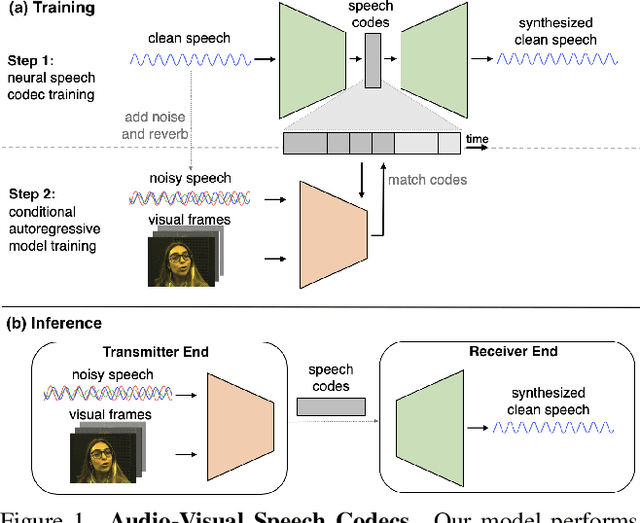

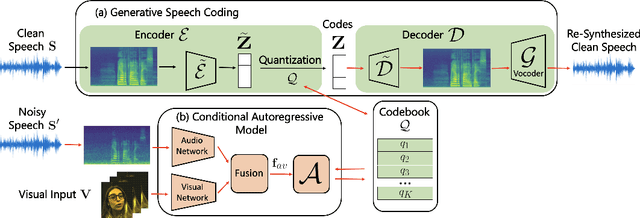

Abstract:Since facial actions such as lip movements contain significant information about speech content, it is not surprising that audio-visual speech enhancement methods are more accurate than their audio-only counterparts. Yet, state-of-the-art approaches still struggle to generate clean, realistic speech without noise artifacts and unnatural distortions in challenging acoustic environments. In this paper, we propose a novel audio-visual speech enhancement framework for high-fidelity telecommunications in AR/VR. Our approach leverages audio-visual speech cues to generate the codes of a neural speech codec, enabling efficient synthesis of clean, realistic speech from noisy signals. Given the importance of speaker-specific cues in speech, we focus on developing personalized models that work well for individual speakers. We demonstrate the efficacy of our approach on a new audio-visual speech dataset collected in an unconstrained, large vocabulary setting, as well as existing audio-visual datasets, outperforming speech enhancement baselines on both quantitative metrics and human evaluation studies. Please see the supplemental video for qualitative results at https://github.com/facebookresearch/facestar/releases/download/paper_materials/video.mp4.
Optimal Transport using GANs for Lineage Tracing
Jul 27, 2020
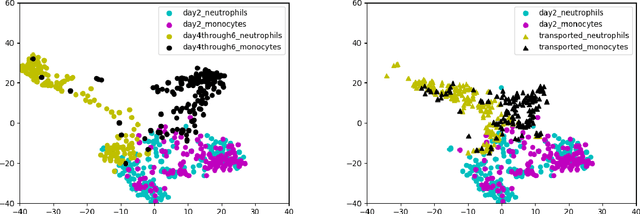


Abstract:In this paper, we present Super-OT, a novel approach to computational lineage tracing that combines a supervised learning framework with optimal transport based on Generative Adversarial Networks (GANs). Unlike previous approaches to lineage tracing, Super-OT has the flexibility to integrate paired data. We benchmark Super-OT based on single-cell RNA-seq data against Waddington-OT, a popular approach for lineage tracing that also employs optimal transport. We show that Super-OT achieves gains over Waddington-OT in predicting the class outcome of cells during differentiation, since it allows the integration of additional information during \mbox{training.}
Improved Conditional Flow Models for Molecule to Image Synthesis
Jun 15, 2020
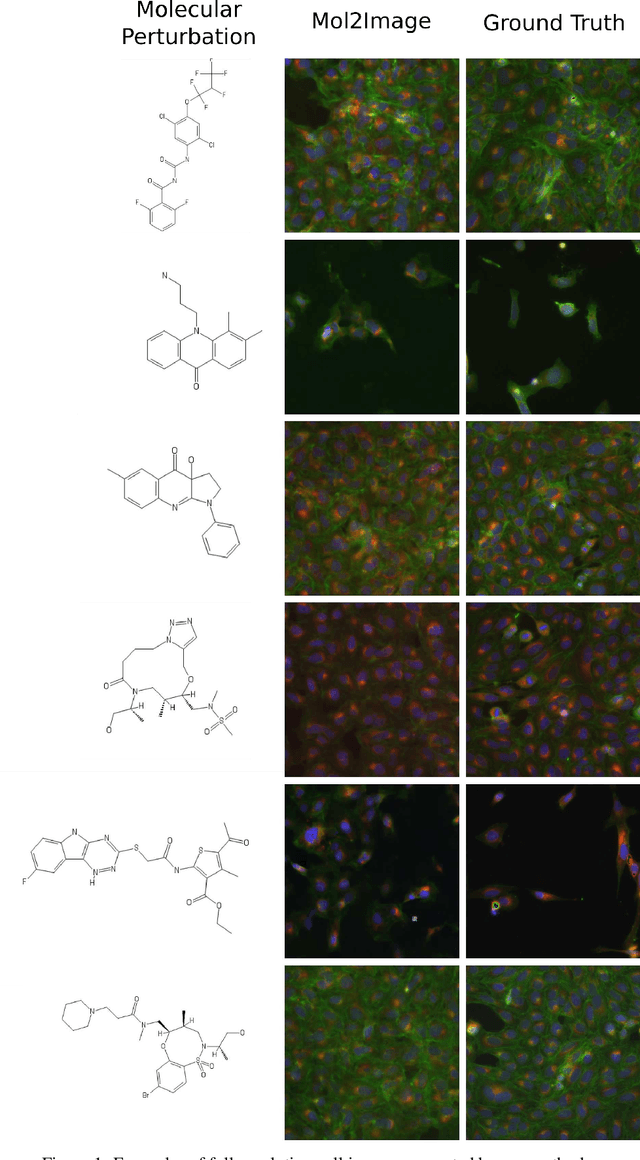

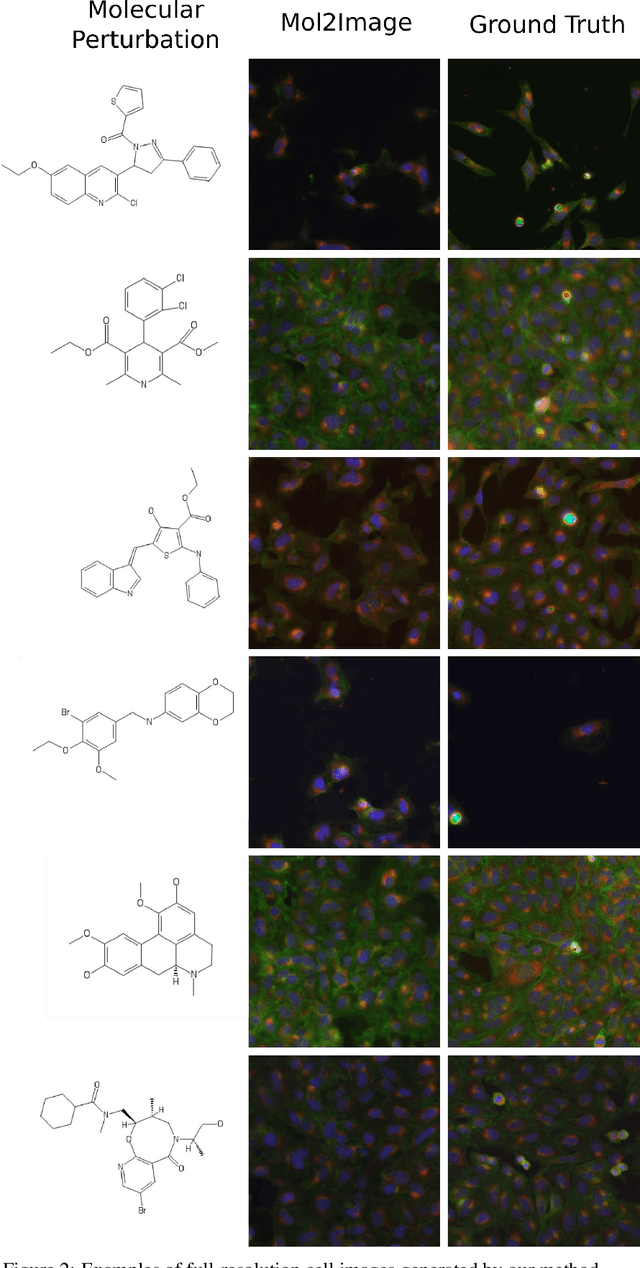
Abstract:In this paper, we aim to synthesize cell microscopy images under different molecular interventions, motivated by practical applications to drug development. Building on the recent success of graph neural networks for learning molecular embeddings and flow-based models for image generation, we propose Mol2Image: a flow-based generative model for molecule to cell image synthesis. To generate cell features at different resolutions and scale to high-resolution images, we develop a novel multi-scale flow architecture based on a Haar wavelet image pyramid. To maximize the mutual information between the generated images and the molecular interventions, we devise a training strategy based on contrastive learning. To evaluate our model, we propose a new set of metrics for biological image generation that are robust, interpretable, and relevant to practitioners. We show quantitatively that our method learns a meaningful embedding of the molecular intervention, which is translated into an image representation reflecting the biological effects of the intervention.
Telling Left from Right: Learning Spatial Correspondence of Sight and Sound
Jun 12, 2020



Abstract:Self-supervised audio-visual learning aims to capture useful representations of video by leveraging correspondences between visual and audio inputs. Existing approaches have focused primarily on matching semantic information between the sensory streams. We propose a novel self-supervised task to leverage an orthogonal principle: matching spatial information in the audio stream to the positions of sound sources in the visual stream. Our approach is simple yet effective. We train a model to determine whether the left and right audio channels have been flipped, forcing it to reason about spatial localization across the visual and audio streams. To train and evaluate our method, we introduce a large-scale video dataset, YouTube-ASMR-300K, with spatial audio comprising over 900 hours of footage. We demonstrate that understanding spatial correspondence enables models to perform better on three audio-visual tasks, achieving quantitative gains over supervised and self-supervised baselines that do not leverage spatial audio cues. We also show how to extend our self-supervised approach to 360 degree videos with ambisonic audio.
 Add to Chrome
Add to Chrome Add to Firefox
Add to Firefox Add to Edge
Add to Edge